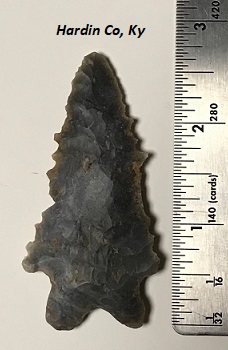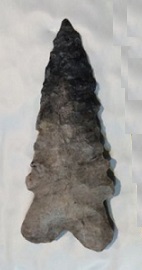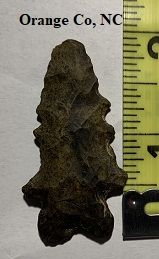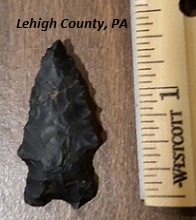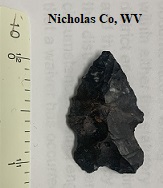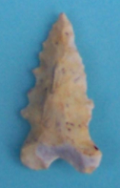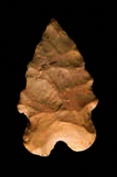Name Details:
Named By: Bettye Broyles
Named For: Type Site
Date Identified: 1966
Type Site: St. Albans site, Kanawha County, West Virginia
St. Albans
Cluster: Rice Lobed Cluster
Commonly Utilized Material:
Date:
Cultural Period:
8,900 - 8,500 B.P.
Early Archaic
Early Holocene
Early Archaic Bifurcated Tradition
Glacial Period:
Tradition:
Outline is Representative of Size and Shape:
Description of Physical Characteristics and Flaking Pattern:
This is a medium triangular bifurcated point with an flattened cross section. The blade is primarily excurvate, but may be straight on some examples. The blade may be serrated.
Shallow side notches for a shoulder that is weak and may vary from horizontal to having an upward slope. The stem is
expanding with a bifurcated base. The deep notched base and the corner notch stem can create large lobed ears. The base
is commonly ground. This point has a random flaking pattern.
Size Measurements: Total Length - 22 to
75mm
(average 35 to 38 mm),
Stem Length - 7 to 15 mm (average 9 to 10 mm), Blade Width - 13 to
32 mm (average 20 to 22 mm), Stem Width at Shoulders - 12 to 20 mm
(average 16 mm), Basal Width - 14 to 24 mm (average 17 to 19 mm), Thickness - 4 to 9 mm.
Distribution:
Distribution Comments:
These points have been found through out the Tennessee River valley and the Ohio River valley and into the mid Mississippi River valley. They have also
been found into southern New York down into Maryland.
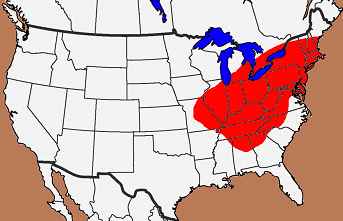
Related / Associated Points:
Additional Comments:
Broyles (1971), has divided this point into type types. The Type A variation has a shorter and wider blade with more defined shoulders, serrated blade, and basal grinding. Type
B variation has a longer narrower blade, lacks serrations, and lacks basal grinding. Broyles states that it would be impossible to distinguish the two types in surface collections, so the two types should not
be separated.
The St. Albans point may be distinguished from the MacCorkle by a base that does not lobe out as far as the MacCorkle point and it lacks the heavy basal grinding seen on the MacCorkle point (W10). The St Albans
is shorter and thicker than the MacCorkle point. This point is similar to the LeCroy point, but the LeCroy point is smaller and thinner than the St Albans point (Schroder, 2012, W18).
The shoulders of the LeCroy point are prominent while the shoulders of the
St Albans are weak.
Please see the website below for more examples of this point.
Point Validity: Valid Type
Broyles is a distinguished
anthropologist who was a professor at many prestigious universities. She is most known for her excavations at St. Albans Site in West Virginia. This type was named in a professional publication and has many professional references. This is a valid type.
.
Age Details:
Broyles (1971) provided a temporal placement as
Early Archaic with a date range of 8,870 B.P. ± 500 years. She felt
that this might be 500 years too early. The St. Albans type occurs before
the LeCroy bifurcated base and after Kirk Corner notched. Chapman (1985)
dated the St. Albans phase between 8,900 and 8,500 B.P. eastern Tennessee
(Whatley, 2002).
References: (See Reference Page, Entry Number):
23, 30, 37, 162, 184, 185, W10, W18
St. Albans Projectile Point, St. Albans Arrowhead

